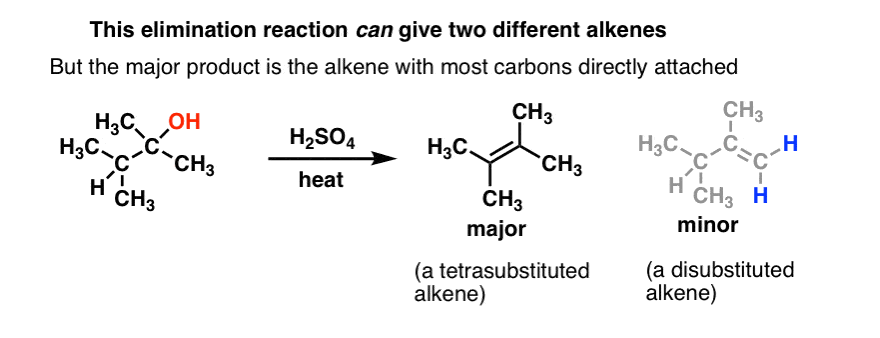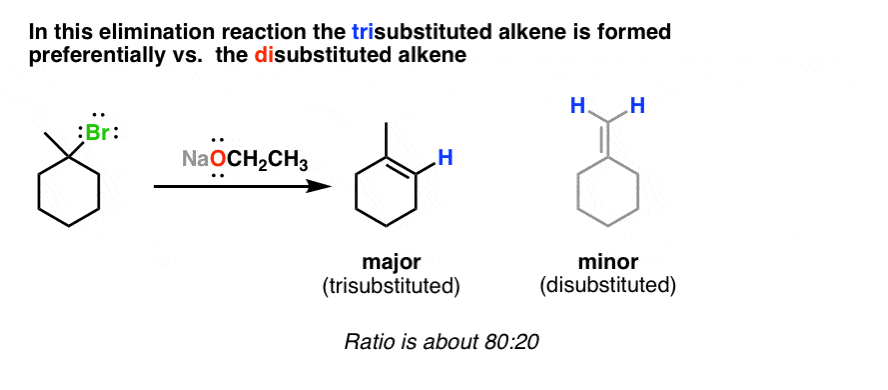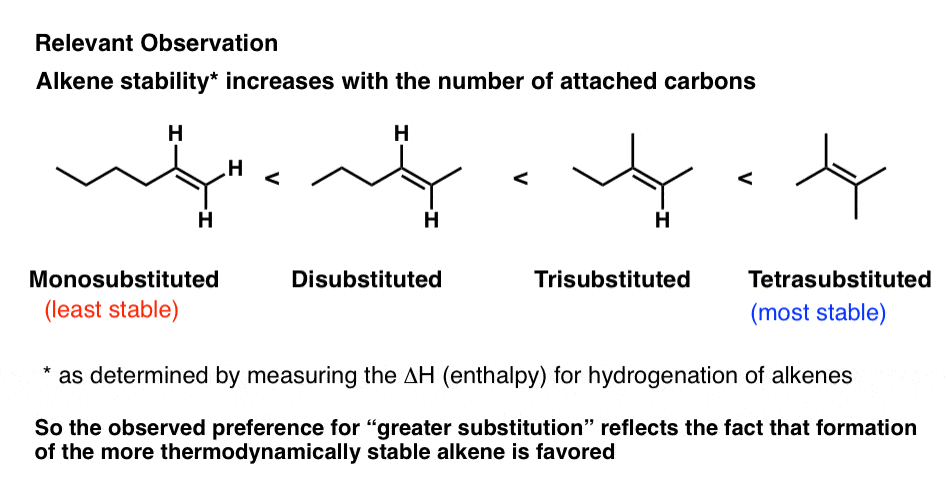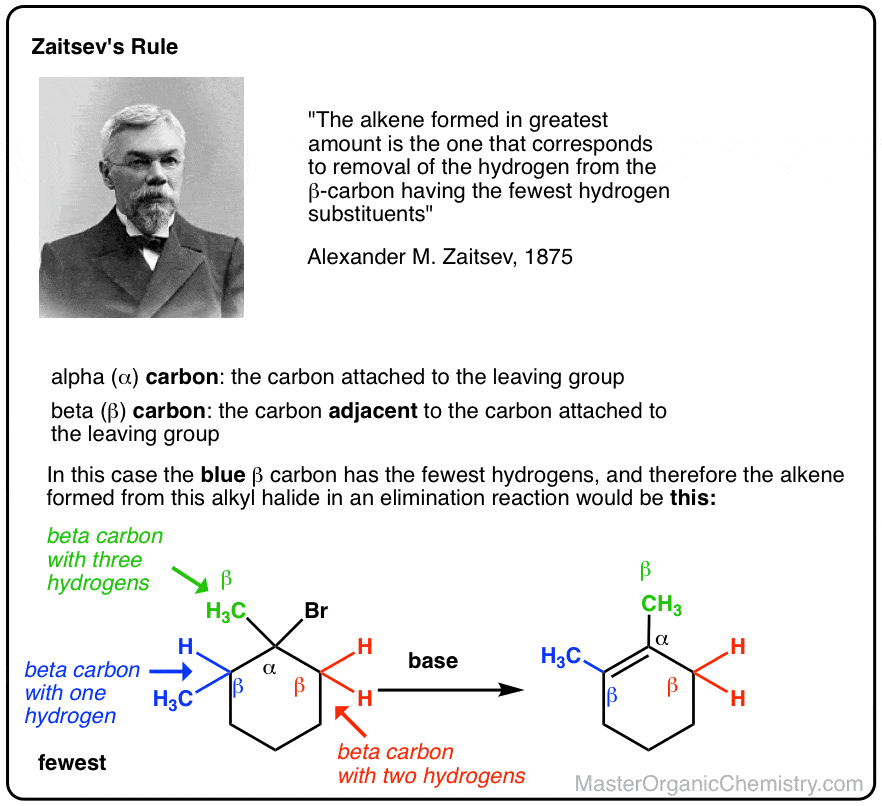Predict The Major Product For The Following Reaction When Drawing Hydrogen Atoms
Elimination Reactions: The Zaitsev Rule
So far, we've only looked at some simple elimination reactions where only one product is possible. In this post we'll look at some examples where we start to see some of the extra "wrinkles" that can be present in elimination reactions.
Table of Contents
- In Elimination Reactions, The "More Substituted" Alkene Tends To Be The Major Product
- The Stability Of Alkenes Increases As C-H Bonds Are Replaced With C–C Bonds
- The "Zaitsev Rule": Elimination Will Occur Such That The Hydrogen Is Removed From The Beta-Carbon With The Fewest Hydrogens
- (Advanced) References and Further Reading
1. In Elimination Reactions, The "More Substituted" Alkene Tends To Be The Major Product
For example, if you heat the alcohol below with a strong acid (like sulfuric acid, H2SO4) you obtain one major product (an alkene) and a minor product (also an alkene).

What's interesting about this? Well, if you look closely you should see that actuallytwo elimination products are possible here, but only one is formed as the major product.
The alkene which is "tetrasubstituted" – that is, attached to four carbon atoms – is the major product, and not the "disubstituted" alkene, which is attached to two carbon atoms and two hydrogen atoms.
(The fact that we're forming a new C-C π bond at the expense of sigma bonds on adjacent carbons is characteristic of elimination reactions.)
Similarly, look at the product of this next reaction. Taking an alkyl bromide and adding a strong base, we again get a "major" product and a "minor product".

Again, the major product is "more substituted" than the minor product. Of the 4 atoms directly attached to the alkene in the major product, 3 of them are carbon and 1 is hydrogen. In the minor product, 2 carbon atoms and 2 hydrogen atoms are directly attached to the alkene.
So what's responsible for this preference for the "more substituted" alkene in elimination reactions?
2. The Stability Of Alkenes Increases As C-H Bonds Are Replaced With C–C Bonds
Well, this correlates nicely with an observation that's been made regarding the heats of formation of various alkenes. As an alkene becomes more substituted (i.e. more carbons attached, fewer hydrogens attached) it becomes more thermodynamically stable. [This observation comes from measuring the enthalpy of hydrogenation for various alkenes – click here for data]

This agrees nicely with the trend that's observed for elimination reactions.The major product of an elimination reaction tends to be the more substituted alkene. This is because the transition state leading to the more substituted alkene is lower in energy and therefore will proceed at a higher rate.
3. The "Zaitsev Rule": Elimination Will Occur Such That The Hydrogen Is Removed From The Beta-Carbon With The Fewest Hydrogens
It was a Russian chemist named Alexander Zaitsev who published a paper making this observation back in the late 19th century, and therefore this observation has become known as Zaitsev's Rule. Formally, the rule is that an elimination will occur such that a hydrogen is removed from the "β-carbon" with the fewest hydrogens. [Organic chemists and their terms: the "α-carbon" is the carbon attached to the leaving group, while "β-carbons" are all carbons attached to the alpha carbon.]

In the next post, we'll go into a little more detail as to why so many elimination reactions seem to have the word "heat" written under them.
Next Post: Elimination Reactions Are Favored By Heat
(Advanced) References and Further Reading
- Zur Kenntniss der Reihenfolge der Analgerung und Ausscheidung der Jodwasserstoffelemente in organischen Verbindungen
Alexander Saytzeff
Liebig. Ann. Chem. 1875, 179 (3), 296-301
DOI: 10.1002/jlac.18751790304
The original paper by Alexander Saytzeff with his observations on elimination reactions, leading to the rule that now bears his name. - The mechanism and kinetics of elimination reactions
D. Hughes and C. K. Ingold
Trans. Faraday Soc. 1941, 657-685
DOI: 10.1039/TF9413700657
Section 3.2 in this paper discusses Zaitsev's Rule. More observations are disclosed, and a possible explanation for the rule (based on hyperconjugation, or the 'Baker-Nathan effect') is provided. - Mechanism of elimination reactions. Part XVI. Constitutional influences in elimination. A general discussion
M. L. Dhar, E. D. Hughes, C. K. Ingold, A. M. M. Mandour, G. A. Maw and L. I. Woolf
J. Chem. Soc. 1948, 2093-2119
DOI: 10.1039/JR9480002093
This paper discusses in detail the differences in conditions and substrate that may cause an E2 reaction to give the Zaitsev or Hofmann product. - Mechanism of elimination reactions. Part XI. Kinetics of olefin elimination from tert.-butyl and tert.-amyl bromides in acidic and alkaline alcoholic media
M. L. Dhar, E. D. Hughes, and C. K. Ingold
J. Chem. Soc. 1948, 2065-2072
DOI: 10.1039/JR9480002065 - Mechanism of elimination reactions. Part XIX. Kinetics and steric course of elimination from isomeric menthyl chlorides
E. D. Hughes, C. K. Ingold, and J. B. Rose
J. Chem. Soc. 1953, 3839-3845
DOI: 10.1039/JR9530003839
This is an example of the Zaitsev rule in a cyclohexane system. Neomenthyl chloride gives 78% 3-menthene and 22% 2-menthene with EtO– in ethanol. - Mechanisms of Elimination Reactions. VI. The Effect of the Leaving Group on Orientation in E2 Reactions
William H. Saunders, Susan R. Fahrenholtz, Edward A. Caress, John P. Lowe, and Madeline SchreiberJournal of the American Chemical Society196587 (15), 3401-3406
DOI: 10.1021/ja01093a020
Very interesting study where 2-halogenopentanes are treated with potassium ethoxide at the boiling point. For leaving groups Cl, Br, and I the dominant elimination product was pent-2-ene (i.e. the Zaitsev product) in 64, 75, and 80% yield respectively. For fluorine, the non-Zaitsev product is formed preferentially! (82% vs 18%).
Predict The Major Product For The Following Reaction When Drawing Hydrogen Atoms
Source: https://www.masterorganicchemistry.com/2012/08/31/elimination-reactions-2-zaitsevs-rule/
Posted by: smithealaings.blogspot.com

0 Response to "Predict The Major Product For The Following Reaction When Drawing Hydrogen Atoms"
Post a Comment